30 Japandi Bedroom Ideas to Create a Calm and Stylish Retreat
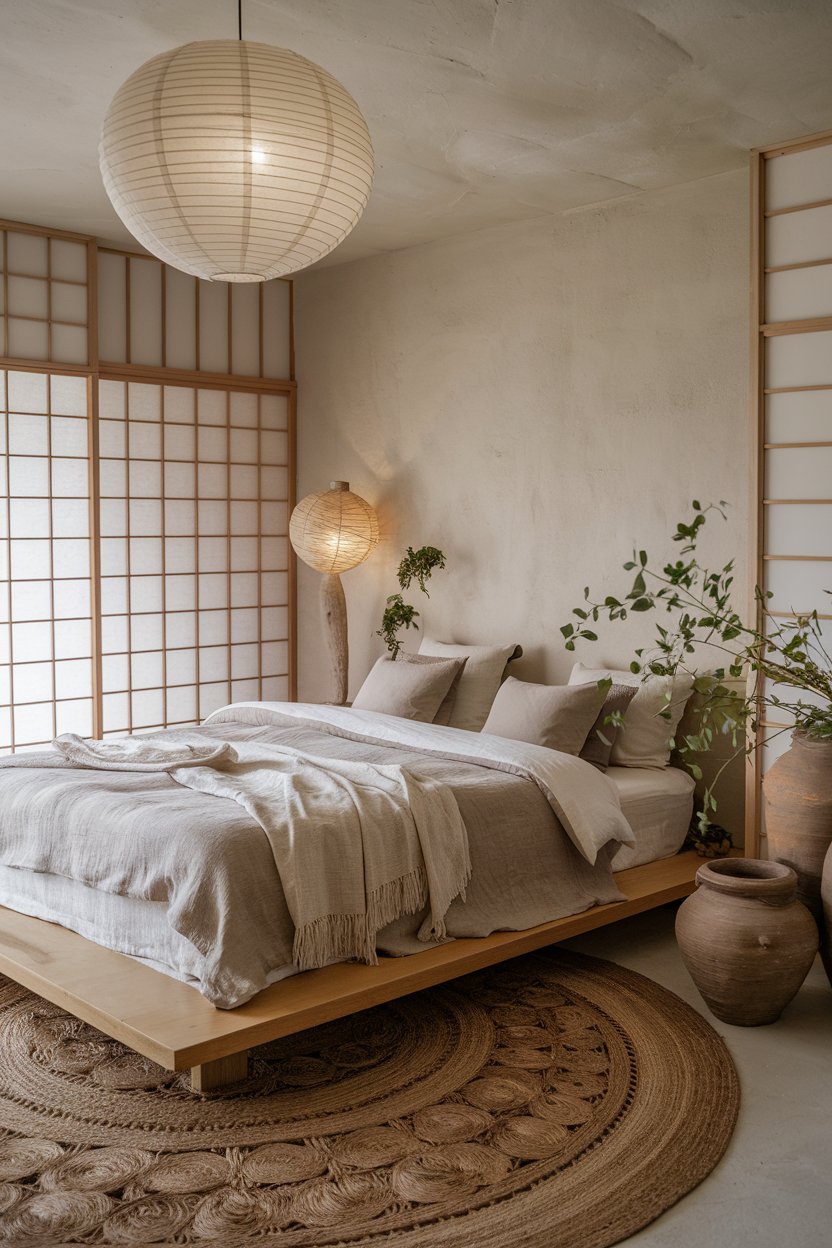
Creating a bedroom that feels both calm and stylish is easier than ever with the timeless beauty of Japandi design. This unique style blends the clean, cozy minimalism of Scandinavian interiors with the natural, soulful elegance of Japanese aesthetics. The result is a harmonious look that’s warm, functional, and effortlessly serene.
At the heart of Japandi design is simplicity-pared-back spaces filled with natural materials, neutral tones, and carefully chosen details. It’s about creating balance: light and dark woods, soft fabrics and raw textures, modern lines and handcrafted accents. Each element works together to form a bedroom that feels uncluttered, grounding, and deeply restorative.
In this article, we’ve gathered 30 inspiring Japandi bedroom ideas to help you design a space that’s both beautiful and practical. From minimalist bed frames and calming color palettes to accent lighting, storage solutions, and serene retreat corners, every idea offers a fresh way to bring Japandi style into your home.
Whether you’re starting from scratch or adding subtle updates, these ideas will guide you toward a bedroom that feels like a sanctuary-one where simplicity and comfort meet in perfect harmony.
1. Neutral Japandi Color Palette
The heart of Japandi design lies in its calming, neutral tones. A well-balanced palette of beige, taupe, ivory, and soft gray creates the serene foundation for any Japandi bedroom. These shades invite a sense of tranquility while reflecting natural light beautifully.
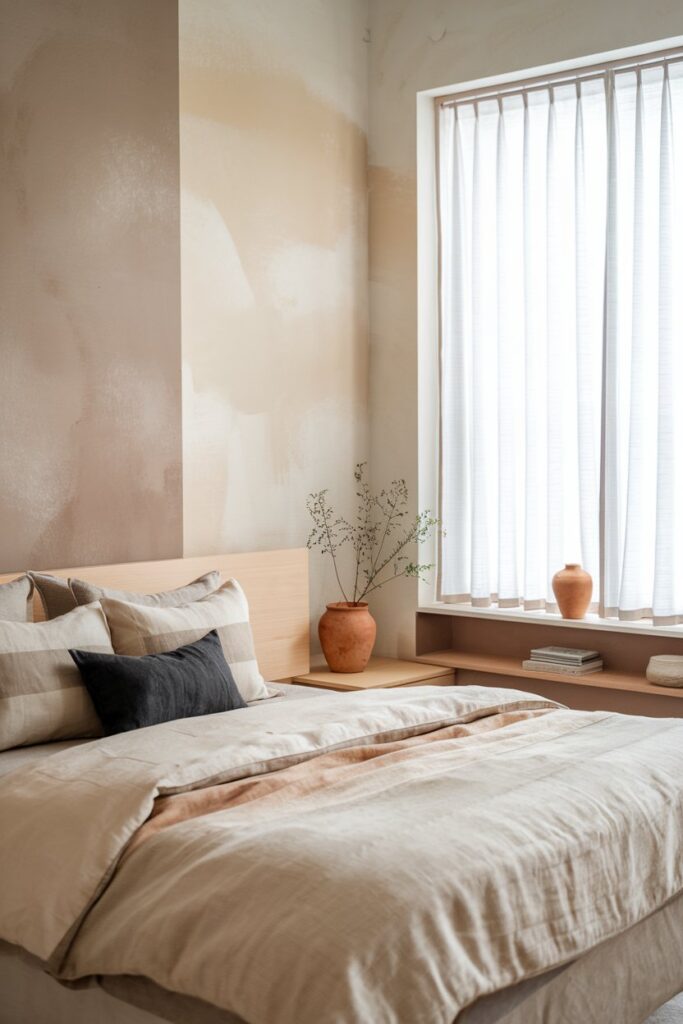
Layering neutrals brings subtle depth and dimension to the space. For example, combine warm cream walls with light oak furniture and soft gray bedding for an effortlessly balanced look.
A touch of muted green or soft blush can be introduced through accents for a hint of contrast. These muted colors still maintain the harmony and simplicity Japandi is known for.
By embracing a neutral palette, you allow textures, materials, and light to take center stage-essential elements in creating a restful Japandi-inspired sanctuary.
2. Minimalist Japandi Bed Frames
A Japandi bedroom starts with the bed, and nothing embodies the style better than a low, minimalist bed frame. Inspired by Japanese futons and Scandinavian simplicity, these frames bring both functionality and beauty.
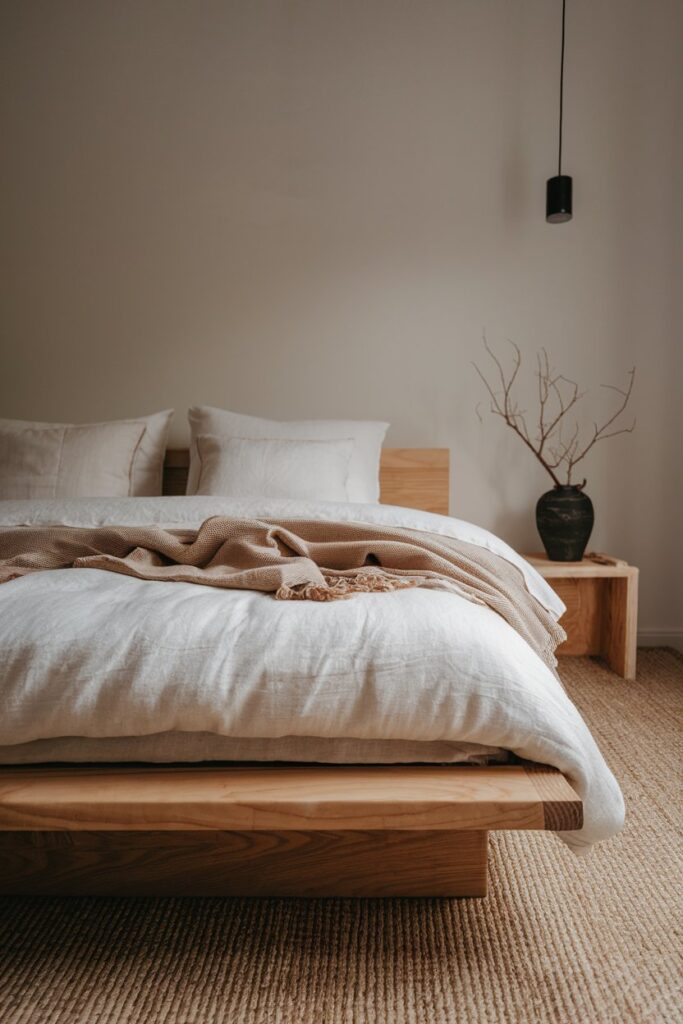
Choose natural wood frames with clean lines to set the tone for the entire room. Their understated design makes them versatile enough to complement any bedding or decor.
Low-profile beds also create a grounded atmosphere, encouraging calmness and relaxation. This design choice subtly blurs the line between furniture and architecture, enhancing the overall flow.
Pair your minimalist frame with soft, organic bedding to complete the serene look, ensuring your bedroom feels like a peaceful retreat.
3. Natural Wood Accents
Wood is central to Japandi design, adding warmth and authenticity to the space. From bed frames to nightstands, oak, walnut, and ash are popular choices that bring natural elegance.
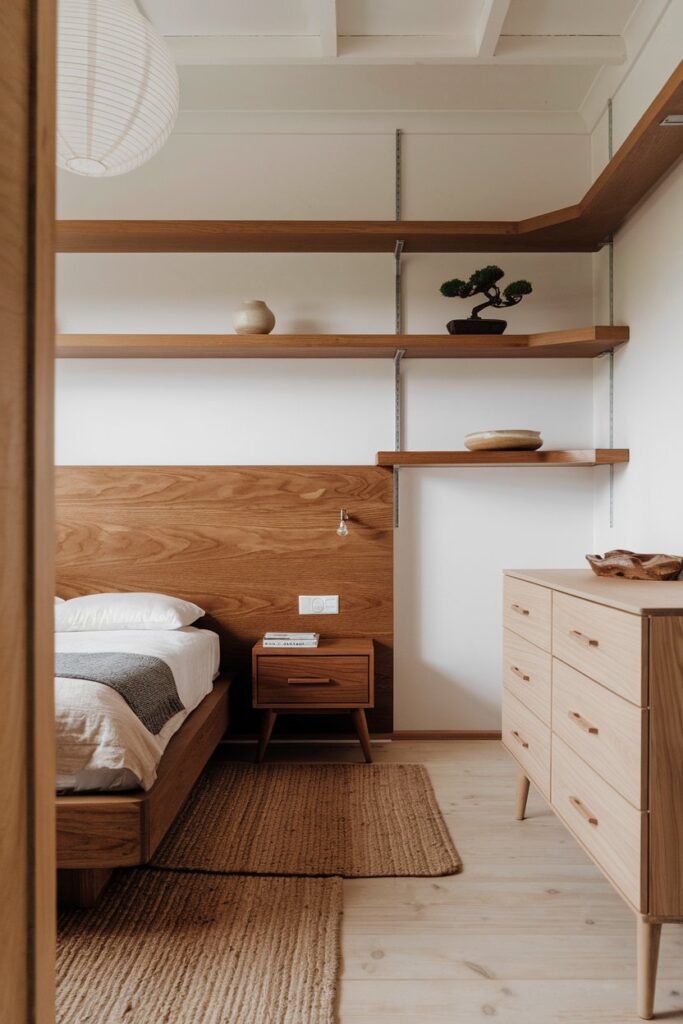
The key is to highlight wood’s organic character. Grain patterns, knots, and natural finishes bring depth and personality without overwhelming the minimalist aesthetic.
Incorporating wood through accent furniture, ceiling beams, or wall panels helps soften the room’s look. Even small touches, like a wooden tray or lamp base, can elevate the design.
Natural wood blends seamlessly with Japandi’s neutral palette, offering both comfort and timeless style. It connects the indoors with nature, one of the movement’s core philosophies.
4. Japandi Bedding Textures
Texture plays a powerful role in Japandi bedrooms, especially through bedding. Natural fabrics like linen, cotton, and hemp add both comfort and visual interest.
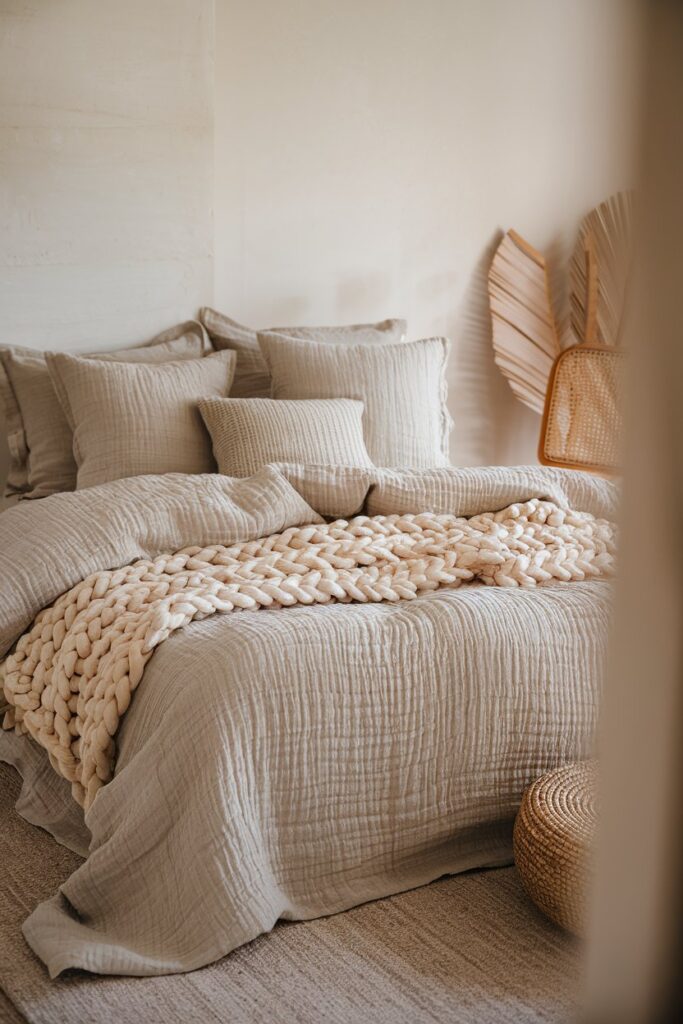
Layering these textiles creates a cozy, inviting bed while maintaining the clean aesthetic Japandi design is known for. Think crisp linen sheets, a textured cotton throw, and soft wool pillows.
The goal is to balance simplicity with warmth. Neutral-colored bedding keeps the palette serene while varied textures provide dimension.
By mixing breathable fabrics with organic finishes, you not only enhance comfort but also reinforce the philosophy of mindful, natural living.
5. Tatami-Inspired Flooring
Tatami mats have long been a hallmark of Japanese interiors, offering both function and symbolism. In a Japandi bedroom, they inspire flooring choices that feel warm and natural.
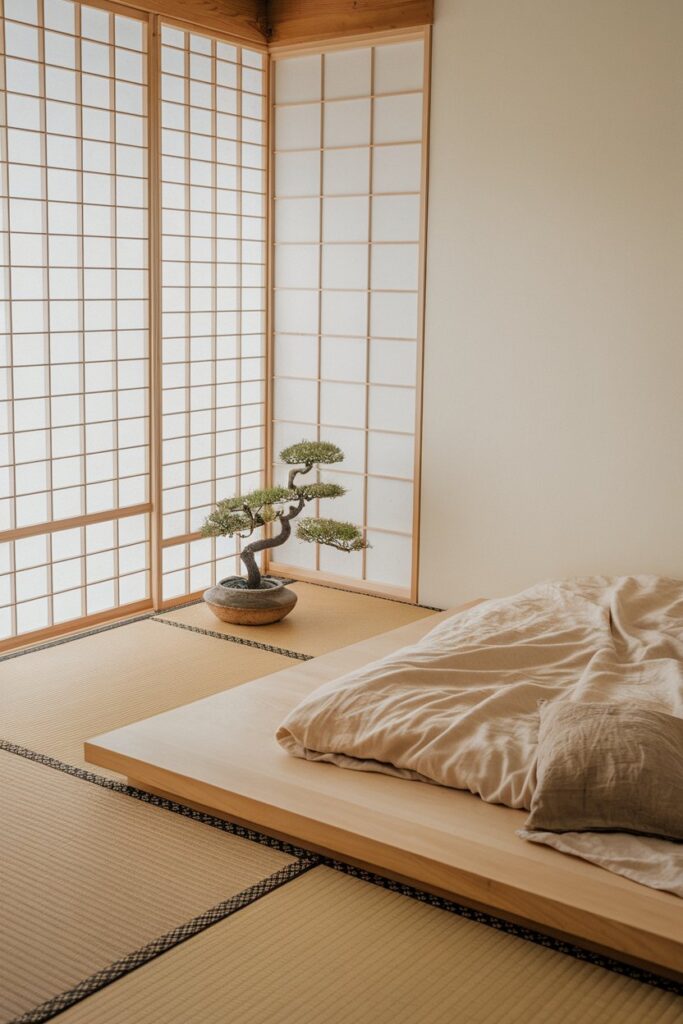
You don’t need authentic tatami to achieve the look. Wide-plank oak, bamboo, or even woven jute rugs can evoke the same grounded feeling.
The beauty lies in the texture and simplicity of the floor. It sets the tone for calmness, allowing furniture and decor to flow naturally across the room.
Tatami-inspired flooring connects the space back to tradition, creating a bridge between Japanese heritage and Scandinavian practicality. It’s the perfect foundation for a peaceful, balanced retreat.
6. Wabi-Sabi Wall Finishes
Japandi design draws heavily from the Japanese philosophy of wabi-sabi, which embraces imperfection and authenticity. When applied to wall finishes, this approach creates a space that feels soulful and serene.
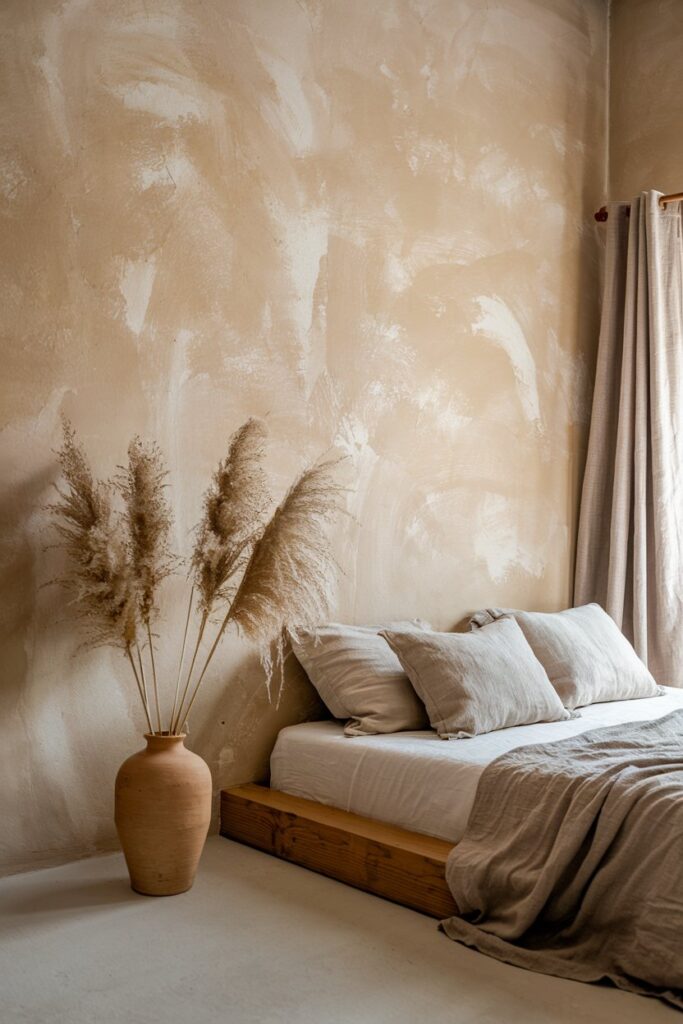
Matte limewash, plaster, or clay finishes add subtle texture while maintaining a natural aesthetic. Unlike glossy, flawless walls, these finishes celebrate variation and depth.
The irregular tones and organic feel of wabi-sabi walls pair beautifully with simple furniture and neutral palettes. They allow your bedroom to feel calm yet full of quiet character.
Consider pairing these finishes with minimal decor to highlight the beauty of the walls themselves. It’s an effortless way to create a backdrop that feels both grounded and timeless.
7. Functional Japandi Storage
Japandi bedrooms prioritize simplicity, and that means smart storage solutions are essential. The goal is to keep the room clutter-free without sacrificing warmth or style.
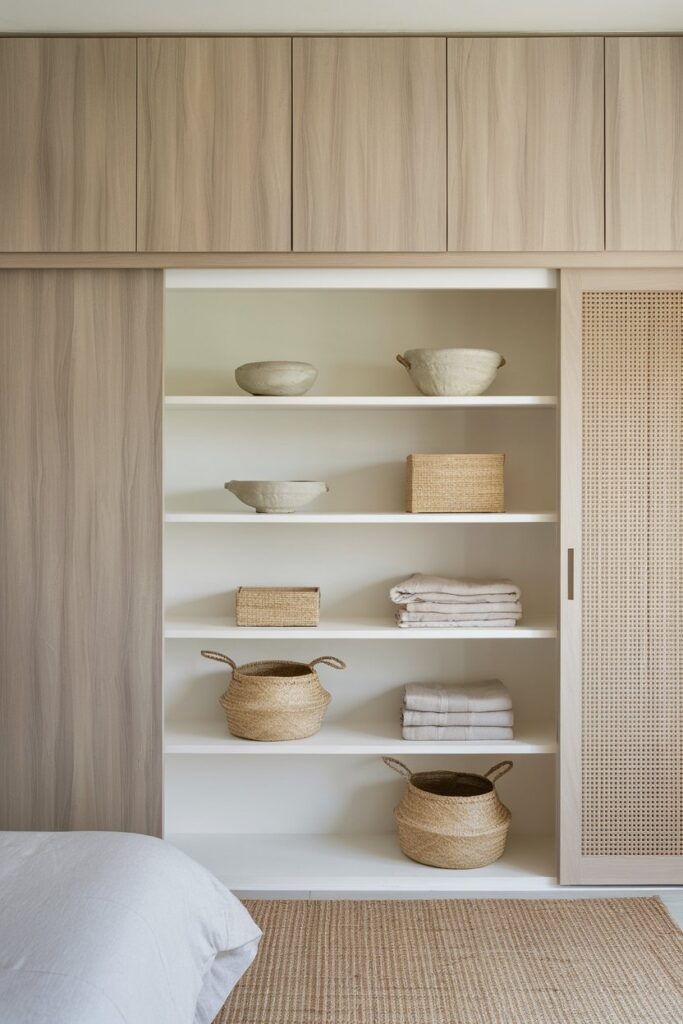
Opt for built-in wardrobes with natural wood finishes, blending seamlessly into the walls. Sliding doors or hidden handles maintain a clean, minimalist appearance.
Bed frames with under-bed drawers, floating shelves, and storage benches can also provide practical organization without overwhelming the space.
By combining function with aesthetic restraint, Japandi storage ensures your bedroom feels calm and balanced, making it a true sanctuary of order and beauty.
8. Japandi Nightstands
Nightstands are a small but impactful element in Japandi bedrooms. Their design should embody simplicity, function, and natural elegance.
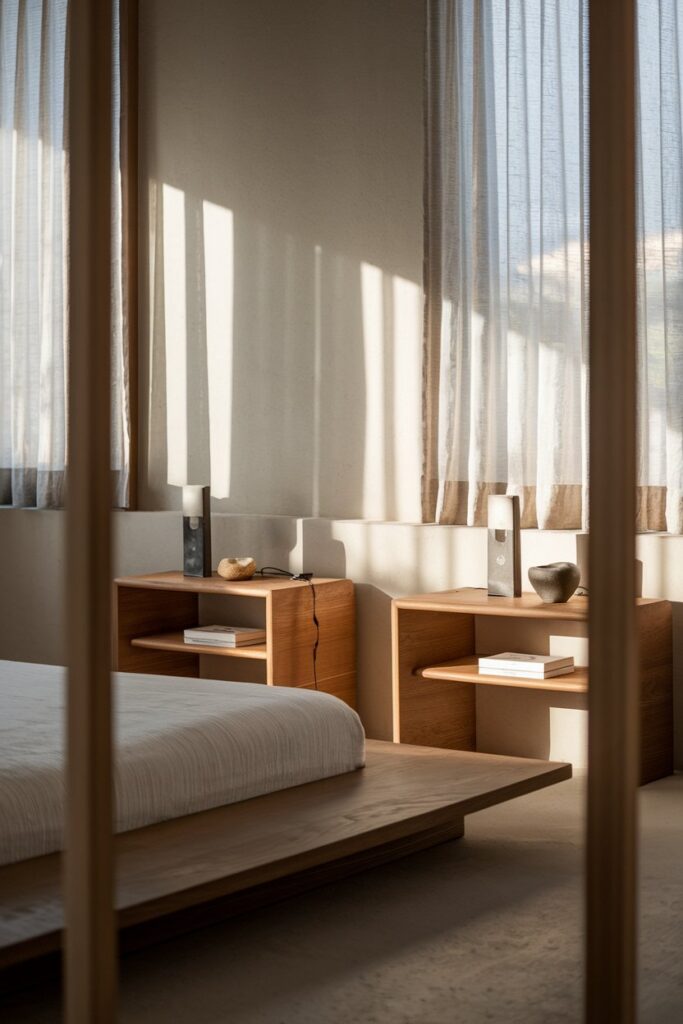
Choose pieces crafted from oak, walnut, or bamboo to align with Japandi’s earthy vibe. A floating nightstand creates a light, airy look, while a compact wooden table offers timeless appeal.
Minimalist shapes work best, ensuring the focus stays on clean lines and natural finishes. Even open shelving or a single drawer can provide practical storage without clutter.
Paired with a soft bedside lamp or a ceramic vase, Japandi nightstands bring harmony to the sleeping area while staying understated and stylish.
9. Accent Lighting
Lighting is central to creating atmosphere in a Japandi bedroom. Instead of harsh overhead lights, the focus is on soft, layered illumination.
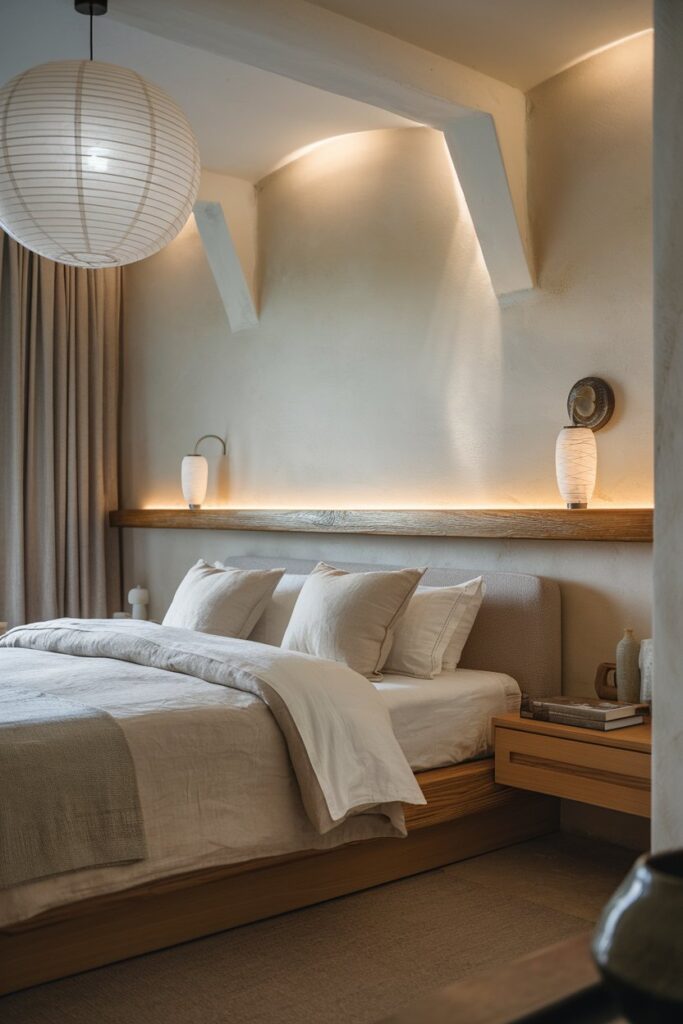
Pendant lights, paper lanterns, or rattan shades add warmth while diffusing light gently across the room. These accents bring a sense of intimacy that aligns with Japandi’s calm aesthetic.
Strategically placing accent lights around the bed, reading nooks, or shelves creates cozy zones within the space. The result is a bedroom that feels both functional and soothing.
Accent lighting highlights the beauty of textures and materials, allowing wood, fabrics, and wall finishes to glow naturally.
10. Floor Lamps with Character
Floor lamps are not just functional-they’re an opportunity to add sculptural beauty to a Japandi bedroom. Their presence can quietly define a corner or reading nook.
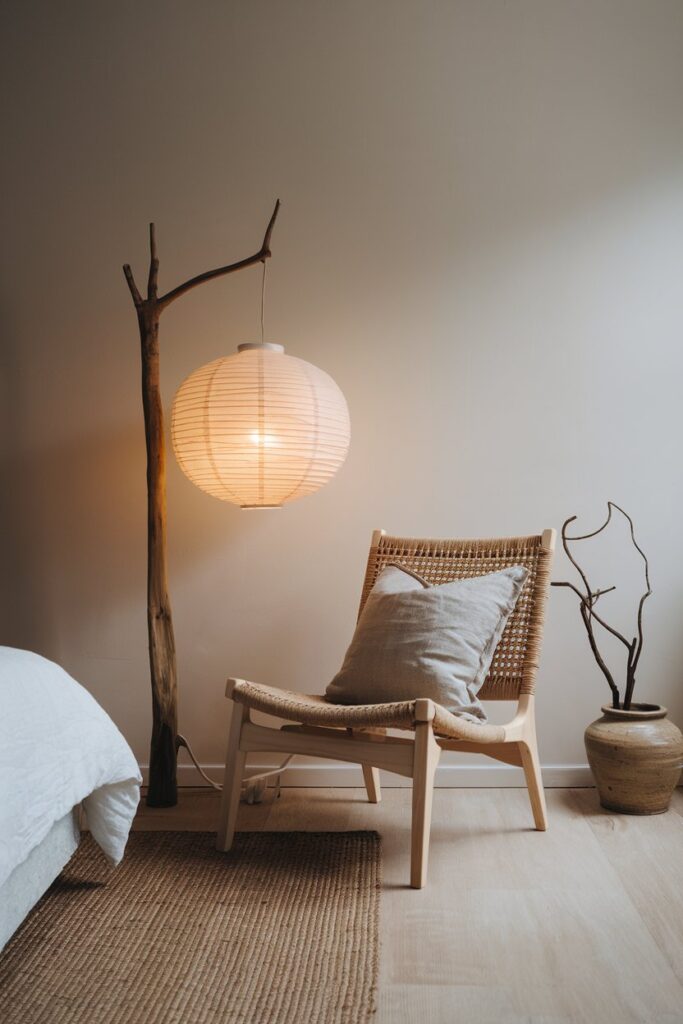
Look for lamps with clean, Scandinavian-inspired forms paired with Japanese-influenced materials like paper or bamboo. A tripod base or curved silhouette adds elegance without excess.
The key is balance: lamps should enhance the room’s natural tones while providing warm, ambient light. Neutral shades and organic finishes work best.
Placed thoughtfully, a floor lamp can transform an unused corner into a peaceful retreat, adding both character and purpose to your Japandi sanctuary.
11. Shoji Screens & Room Dividers
Shoji screens are one of the most iconic Japanese design elements, and they bring a beautiful sense of calm to Japandi bedrooms. Their translucent panels allow natural light to filter softly, creating a warm and serene atmosphere.
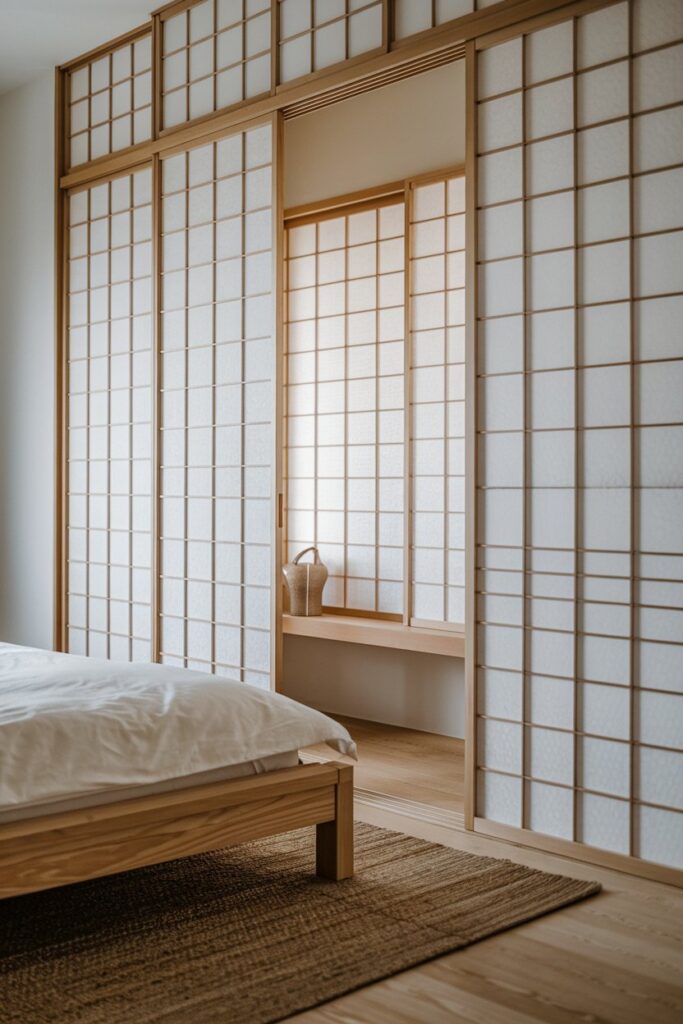
Using a shoji screen as a room divider adds both function and elegance. It can separate a sleeping area from a reading nook or dressing space without closing off the room completely.
These lightweight dividers also introduce texture and rhythm through their wooden grids, pairing perfectly with minimalist Scandinavian furniture.
Incorporating a shoji screen not only enhances privacy but also adds a timeless element of Japanese heritage that complements the simplicity of Nordic design.
12. Japandi Sliding Doors
Sliding doors are a hallmark of both Japanese and Scandinavian interiors, making them a natural fit for Japandi bedrooms. They save space while creating smooth transitions between rooms.
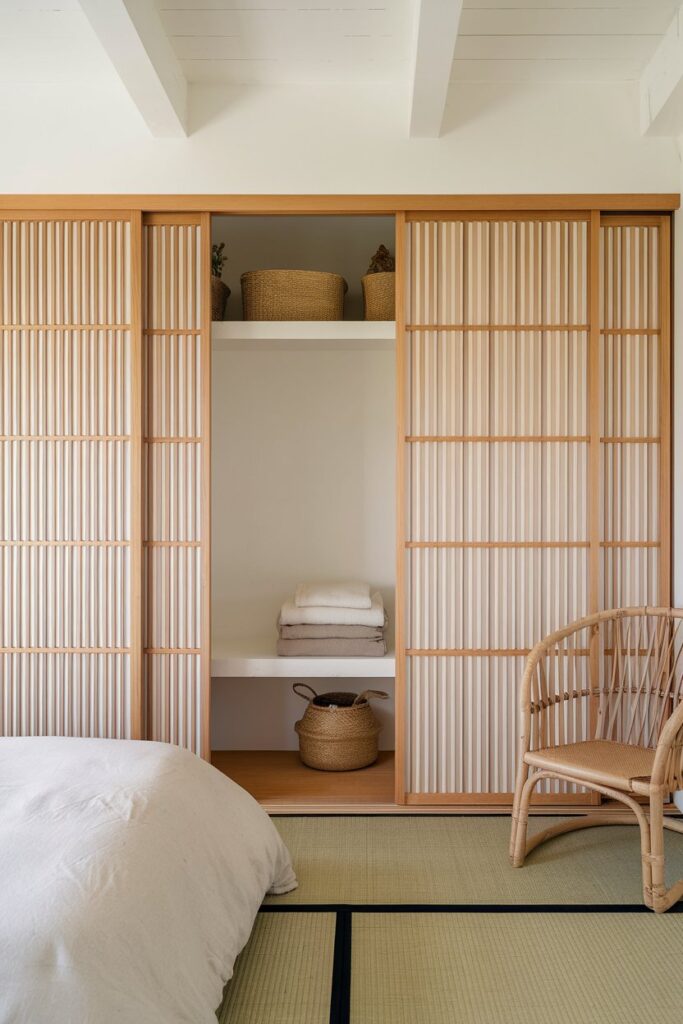
Opt for wood-framed panels with frosted glass or light-toned finishes to keep the look airy and minimal. These doors allow light to travel freely, enhancing the sense of openness.
In smaller bedrooms, sliding doors can be especially practical-eliminating the need for swinging space while maintaining elegance.
The combination of clean lines and natural materials makes sliding doors a perfect reflection of Japandi’s balance between beauty and utility.
13. Calming Greenery
Plants play a vital role in Japandi design, offering a connection to nature and a sense of vitality. The goal is to choose greenery that feels intentional and understated.
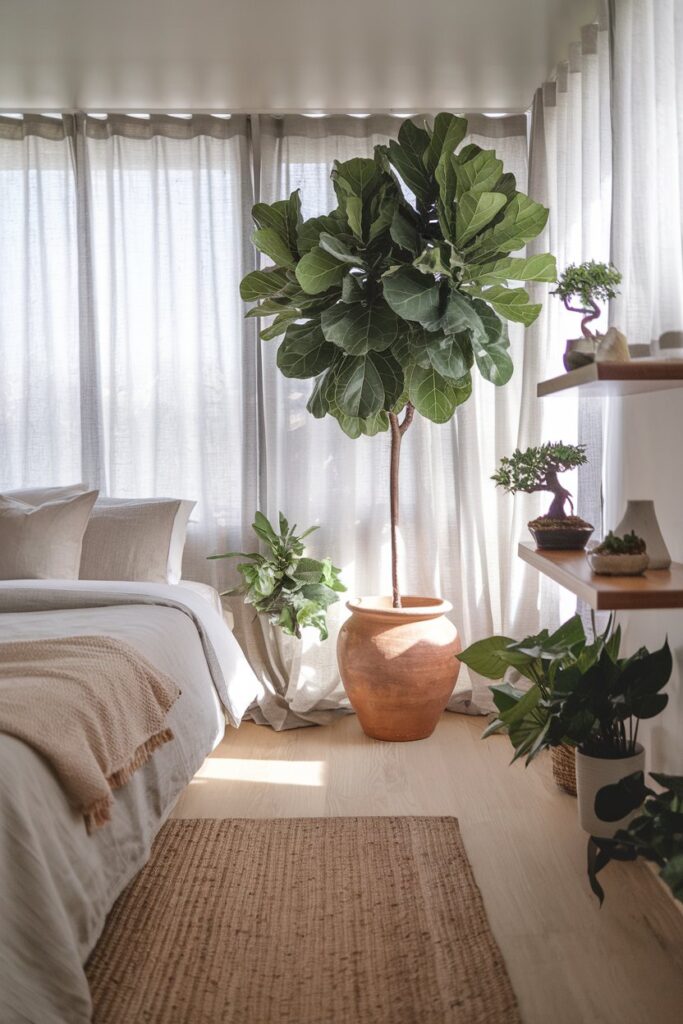
Think bonsai trees, potted fiddle leaf figs, or simple branches in ceramic vases. Each brings life to the room without overpowering its serene atmosphere.
Placement is just as important as selection. A single plant near a window or beside the bed creates harmony and balance.
Calming greenery softens the minimal aesthetic of Japandi bedrooms, adding freshness while reinforcing the philosophy of living in tune with nature.
14. Japandi Wall Art
Wall art in a Japandi bedroom should be minimalist yet meaningful, enhancing the overall mood rather than dominating it. Abstract Scandinavian prints and Japanese ink-inspired works pair beautifully together.
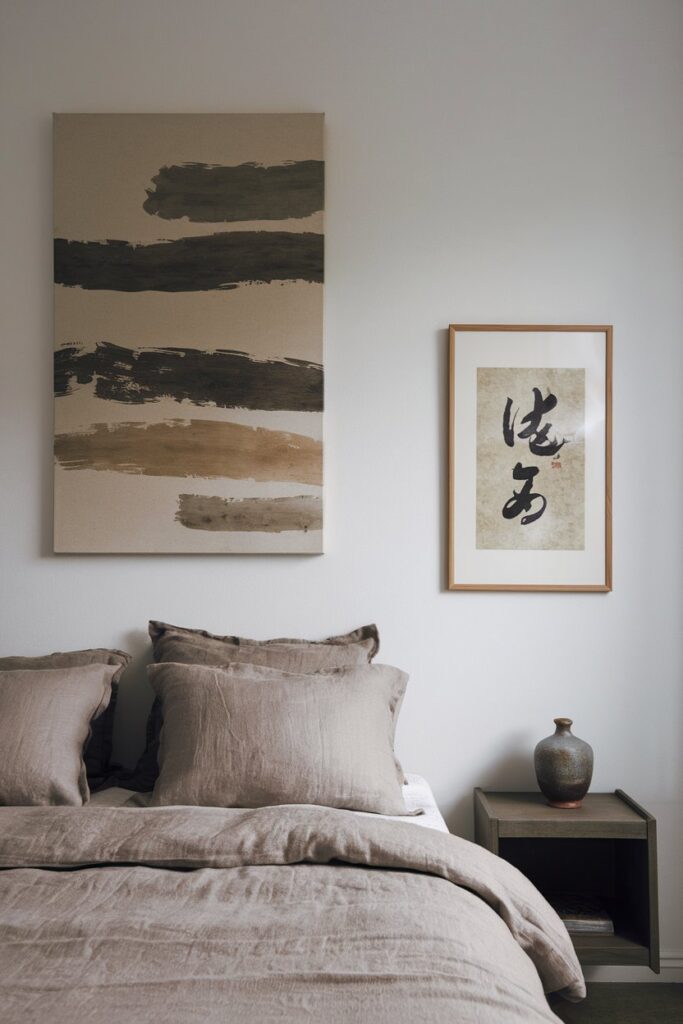
Choose neutral tones or subtle washes of muted color to keep the artwork in harmony with the room’s palette.
Large-scale pieces can make a statement, while smaller, carefully arranged artworks create a curated gallery wall effect.
By keeping the selection minimal and intentional, wall art becomes a quiet reflection of both cultures-adding depth while maintaining balance.
15. Ceramic & Clay Decor
Ceramic and clay decor bring handcrafted beauty into a Japandi bedroom. Their organic shapes and earthy textures add warmth to a minimalist space.
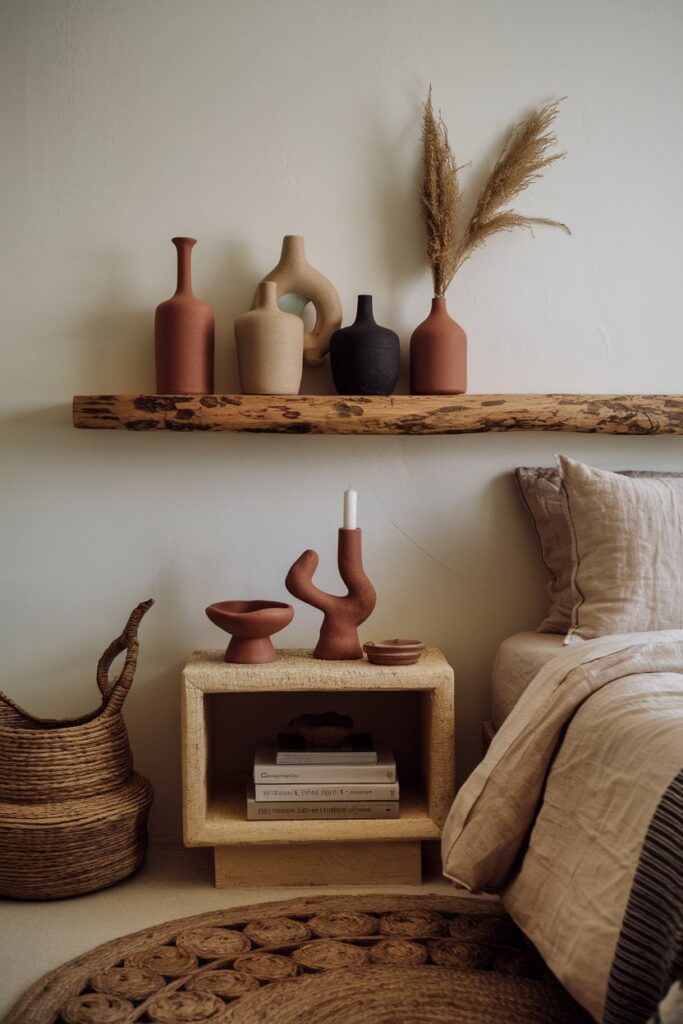
A ceramic vase with simple branches, a clay lamp base, or handmade bowls can serve as functional yet artistic accents.
These pieces highlight the imperfections of craftsmanship, aligning with wabi-sabi principles while blending seamlessly with Scandinavian restraint.
By incorporating ceramic and clay, homeowners can introduce tactile, timeless elements that enrich the bedroom with both artistry and authenticity.
Quick Guide to Japandi Bedroom Essentials
| Element | Key Features | Styling Tip for Homeowners |
| Color Palette | Neutral shades: beige, gray, taupe | Layer soft neutrals with one muted accent color |
| Bed Frames | Low-profile, minimalist wooden designs | Pair with linen bedding for a calming retreat |
| Storage Solutions | Built-ins, sliding doors, hidden drawers | Keep surfaces clutter-free for a serene look |
| Lighting | Soft, layered, natural materials | Use paper lamps or rattan pendants for ambiance |
| Wall Finishes | Limewash, plaster, wabi-sabi textures | Highlight imperfections for natural character |
| Accents & Decor | Ceramic, clay, stone, handcrafted items | Choose a few meaningful pieces over many objects |
| Furniture Tones | Mix of light and dark woods | Balance oak or ash with walnut or ebony accents |
| Greenery | Bonsai, simple potted plants | Place sparingly for balance and freshness |
| Textiles | Linen, cotton, hemp in soft tones | Layer rugs, cushions, and throws for warmth |
16. Japandi Rugs
Rugs in a Japandi bedroom serve more than a functional purpose-they add warmth, texture, and grounding to the minimalist design. The key is to choose natural, organic materials.
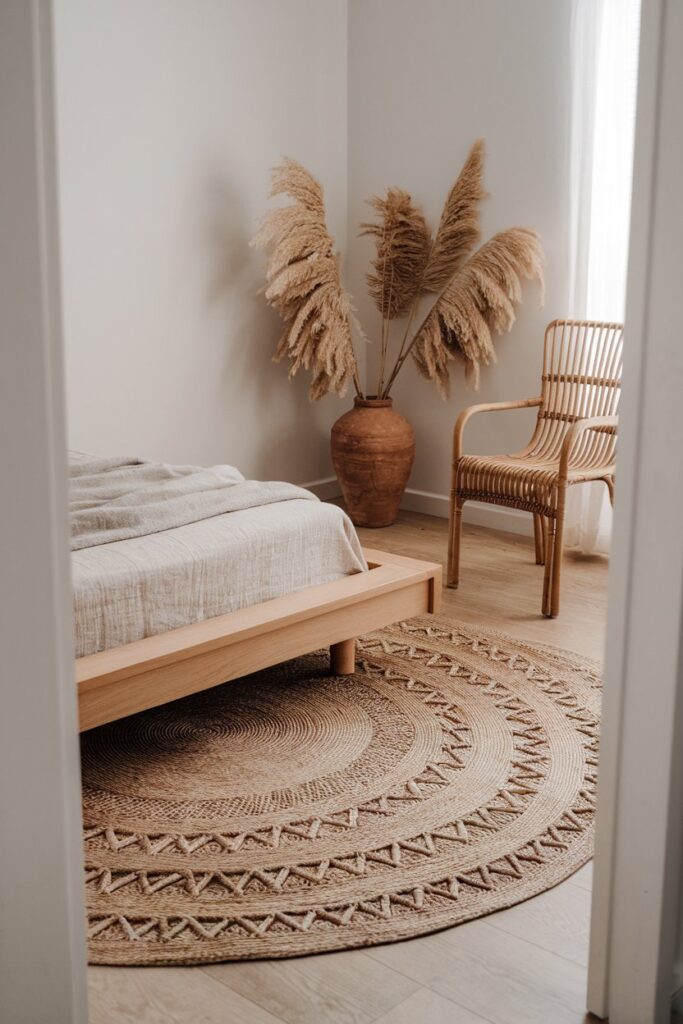
Jute, sisal, or handwoven wool rugs are excellent choices. Their subtle patterns and earthy tones blend seamlessly with neutral color palettes.
A rug can also define zones within the bedroom, such as beneath the bed or in a cozy reading corner. This helps bring structure while maintaining flow.
By selecting rugs with understated beauty, you add comfort underfoot and reinforce Japandi’s philosophy of simple, natural living.
17. Layered Curtains & Shades
Japandi bedrooms thrive on soft, filtered light, and layered window treatments create the perfect atmosphere. Combining sheer curtains with heavier linen drapes is both practical and beautiful.
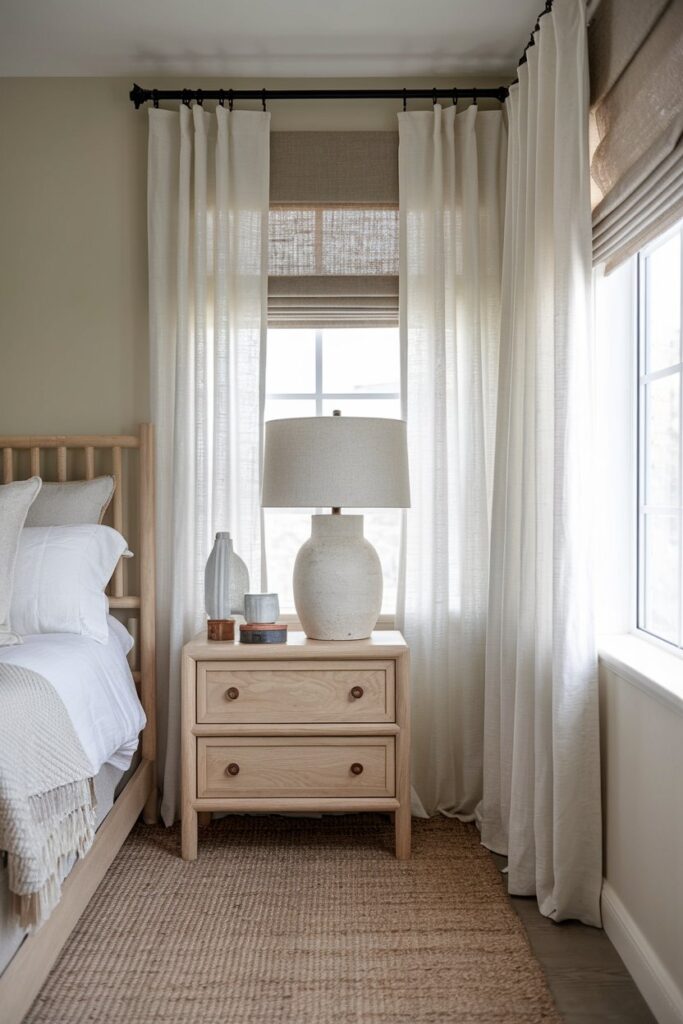
Sheers allow daylight to flow in gently, while thicker curtains provide privacy and coziness when needed. Together, they create a balance of openness and comfort.
Natural fabrics in muted tones work best, adding texture without overwhelming the space. Even simple bamboo blinds can be layered with drapery for an elegant touch.
The result is a window treatment that feels serene, functional, and deeply connected to Japandi design principles.
18. Statement Japandi Pendant Lights
Pendant lighting is a wonderful way to introduce a focal point into a Japandi bedroom. Statement pieces combine clean Scandinavian lines with organic Japanese-inspired materials.
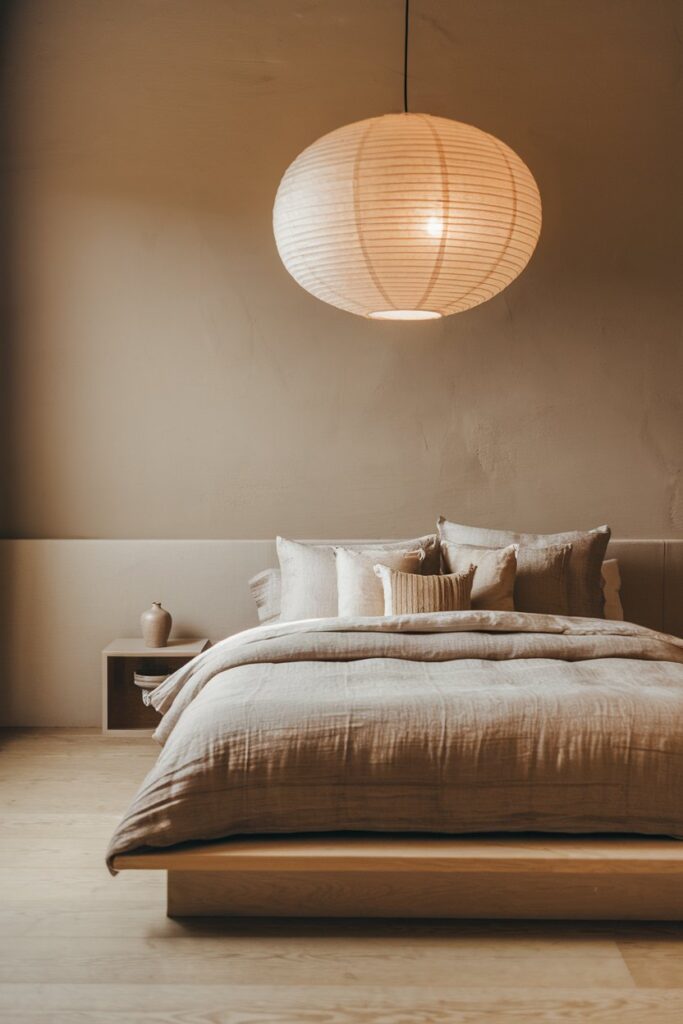
Look for pendants crafted from rattan, rice paper, or linen, which diffuse light softly and naturally. Their sculptural forms create beauty without excess.
Hanging a pendant above the bed or in a reading nook adds drama while maintaining simplicity. It becomes both a functional light source and an artful detail.
The right pendant light elevates the space, reminding us that Japandi design values harmony between form and function.
19. Mix of Dark and Light Woods
A signature element of Japandi interiors is the blend of light Scandinavian woods with the richness of Japanese darker tones. This contrast brings depth and sophistication.
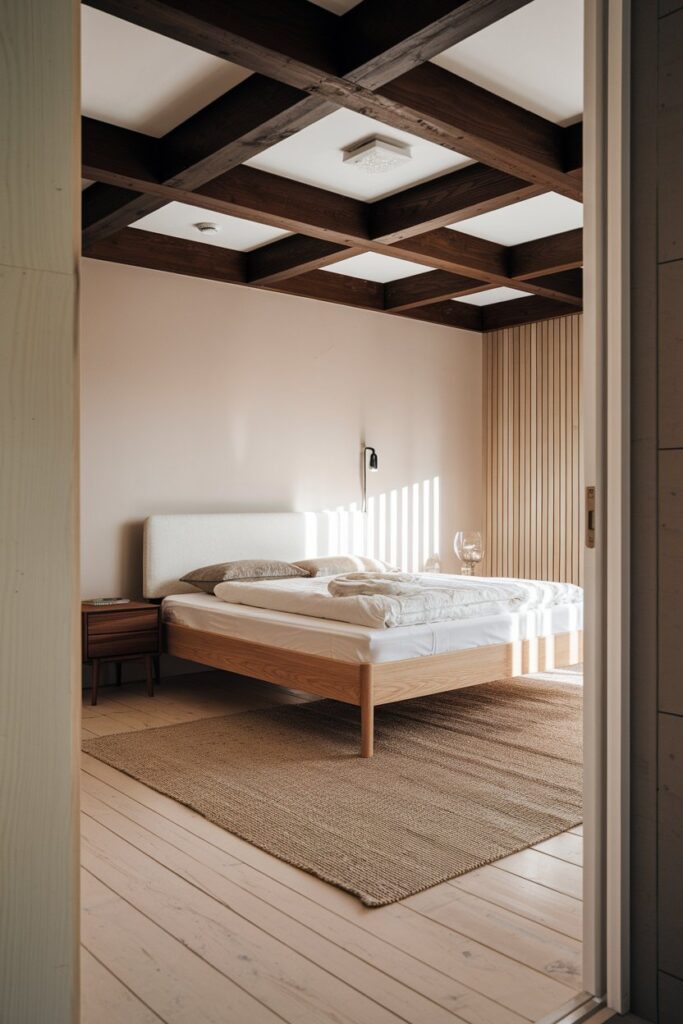
Light oak or ash can be paired with walnut or ebony to create balance. The interplay between these tones highlights each piece’s character.
In a bedroom, this mix could appear in furniture, flooring, or even small accents like shelving and frames. The variety feels natural and timeless.
By layering woods in this way, you create visual interest while staying true to Japandi’s warm and harmonious aesthetic.
20. Japandi Accent Chairs
An accent chair can transform a Japandi bedroom into a multifunctional retreat. It offers a place to read, relax, or simply admire the space.
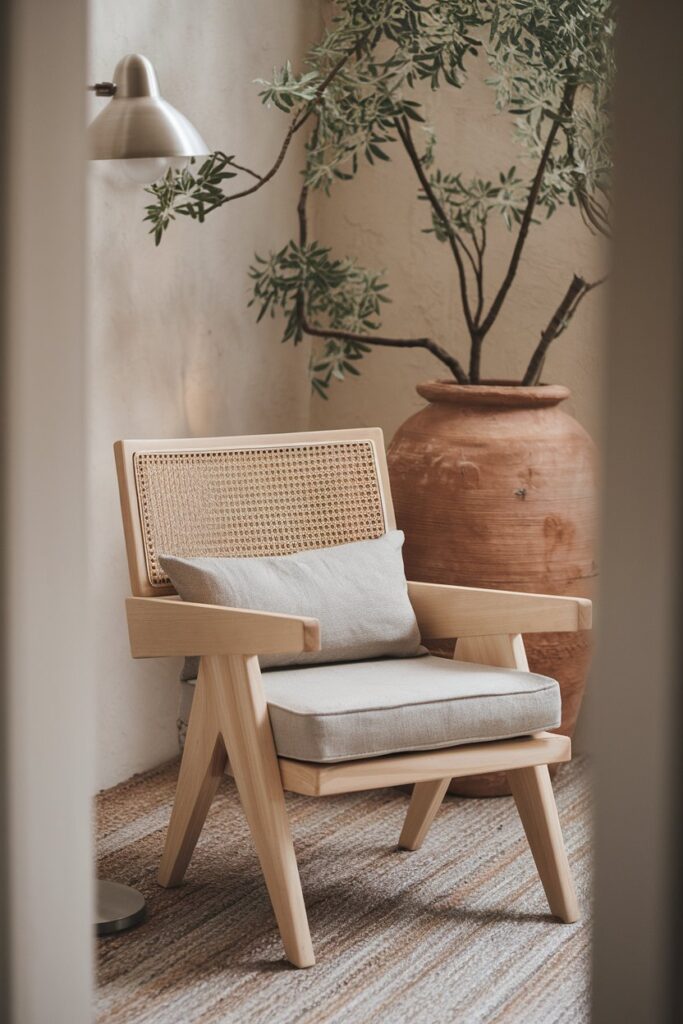
Choose chairs with clean, minimalist silhouettes paired with natural materials like wood, linen, or cane. Comfort and elegance should coexist.
Position the chair near a window, floor lamp, or small side table to create an intentional nook. This enhances both function and flow.
A Japandi accent chair serves as more than seating-it embodies simplicity, balance, and the quiet luxury of intentional design.
21. Minimalist Wall Shelves
Minimalist wall shelves are a perfect way to combine storage and style in a Japandi bedroom. Their clean lines and natural finishes create both order and beauty.
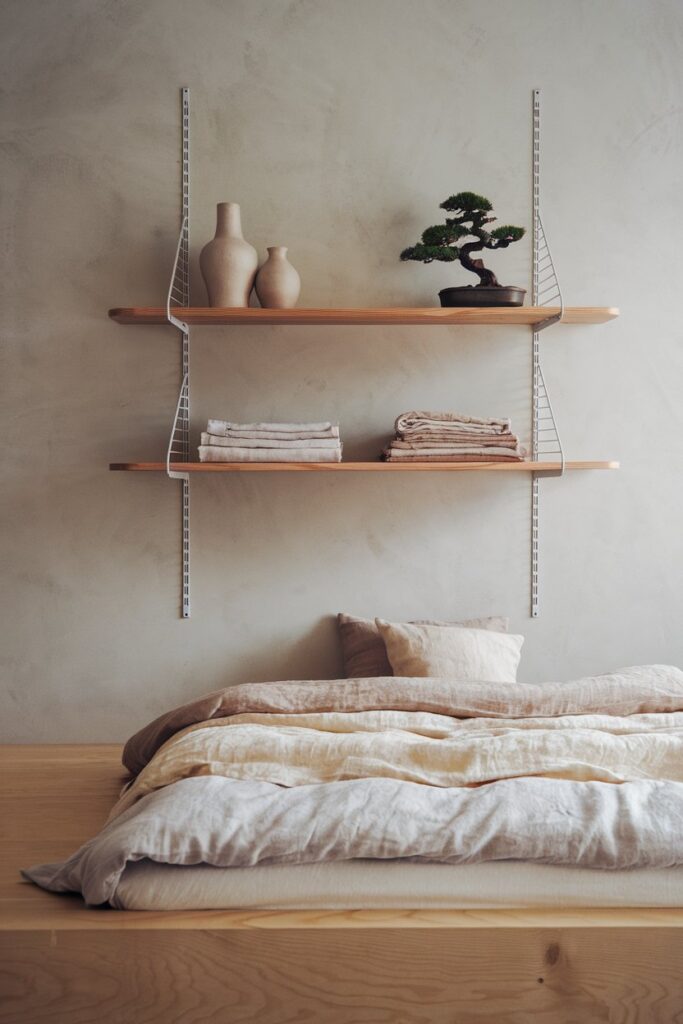
Floating wooden shelves in oak, walnut, or bamboo add warmth while keeping the look light and uncluttered. They appear almost weightless, contributing to the calm atmosphere.
Keep shelf styling simple-think a few ceramic vases, neatly stacked books, or a single piece of greenery. Less truly is more in Japandi design.
By incorporating minimalist shelving, you gain functional storage while maintaining the serenity and balance central to Japandi aesthetics.
22. Organic Shaped Mirrors
Mirrors can do more than reflect light-they can also serve as sculptural accents. In a Japandi bedroom, organic-shaped mirrors bring softness to clean-lined interiors.
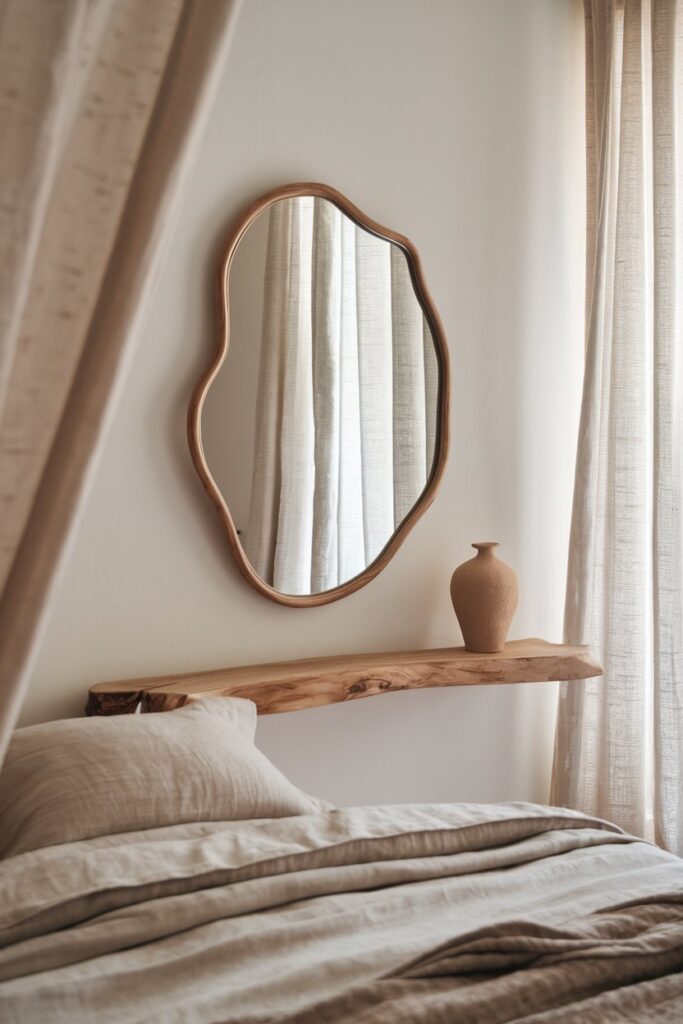
Look for designs with irregular curves or round frames in natural wood. These shapes echo the imperfect beauty of nature while staying understated.
Positioning a mirror near a window enhances natural light, making the room feel more spacious and airy.
Organic mirrors act as subtle statement pieces, offering both function and artistry in alignment with Japandi’s calm elegance.
23. Low Japanese-Style Seating
Low seating embodies the Japanese influence in Japandi interiors, bringing the room closer to the ground and enhancing a sense of calm.
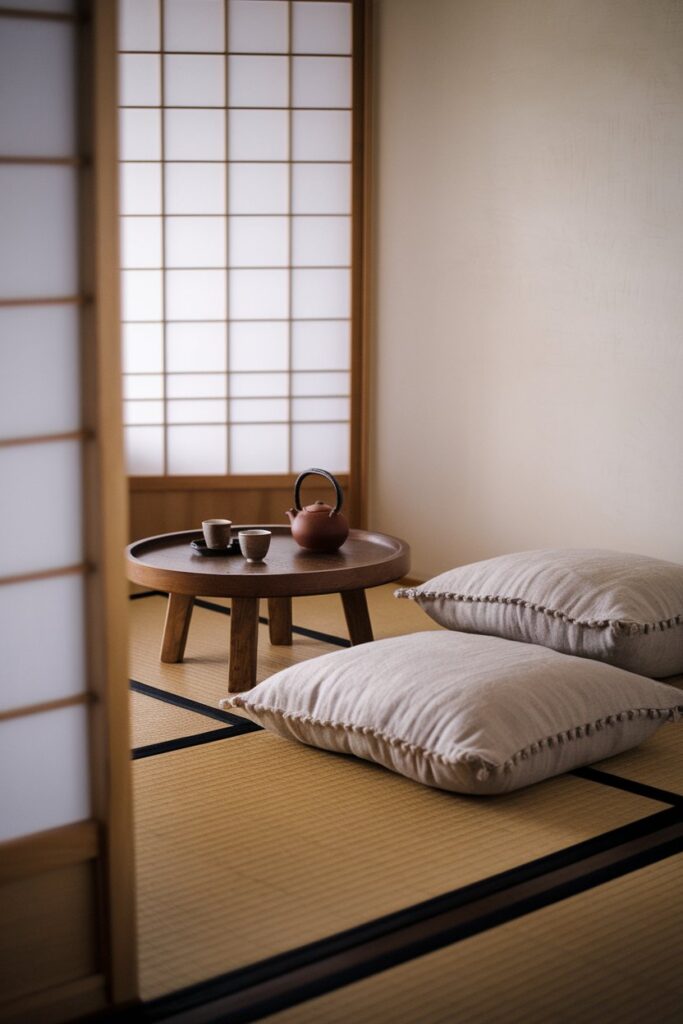
Floor cushions, tatami mats, or low wooden benches are great ways to incorporate this tradition into a bedroom. They encourage relaxation and mindful living.
Paired with a small side table or layered rugs, low seating creates an inviting corner for tea, reading, or quiet reflection.
This design choice reminds us of simplicity and presence, qualities that make Japandi bedrooms feel like sanctuaries.
24. Japandi Work Nooks
A Japandi work nook proves that even practical spaces can be serene and stylish. The key is to keep the design minimal and clutter-free.
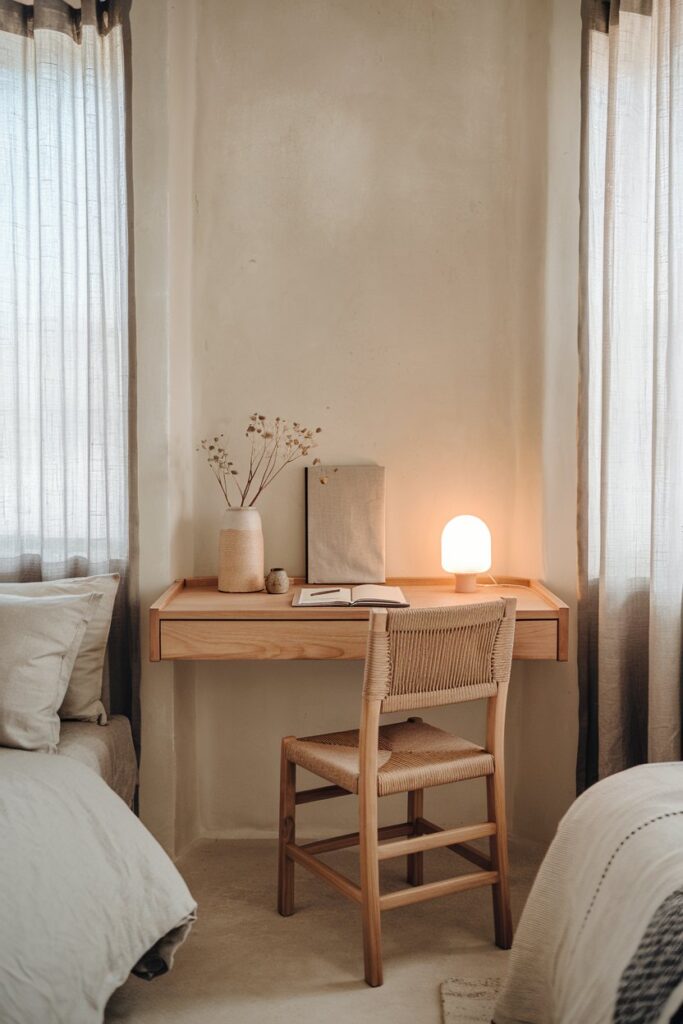
Choose a simple wooden desk with clean lines, paired with a comfortable yet understated chair. Natural finishes help the nook blend seamlessly with the bedroom.
Keep accessories minimal-perhaps a ceramic pen holder, a single plant, or a small lamp for warm lighting. This preserves the calm atmosphere.
By integrating a Japandi work nook, you create a space that encourages focus and creativity while maintaining the tranquility of your bedroom.
25. Calm Japandi Reading Corners
A reading corner is one of the most inviting features of a Japandi bedroom. It combines function with the restorative beauty of design.
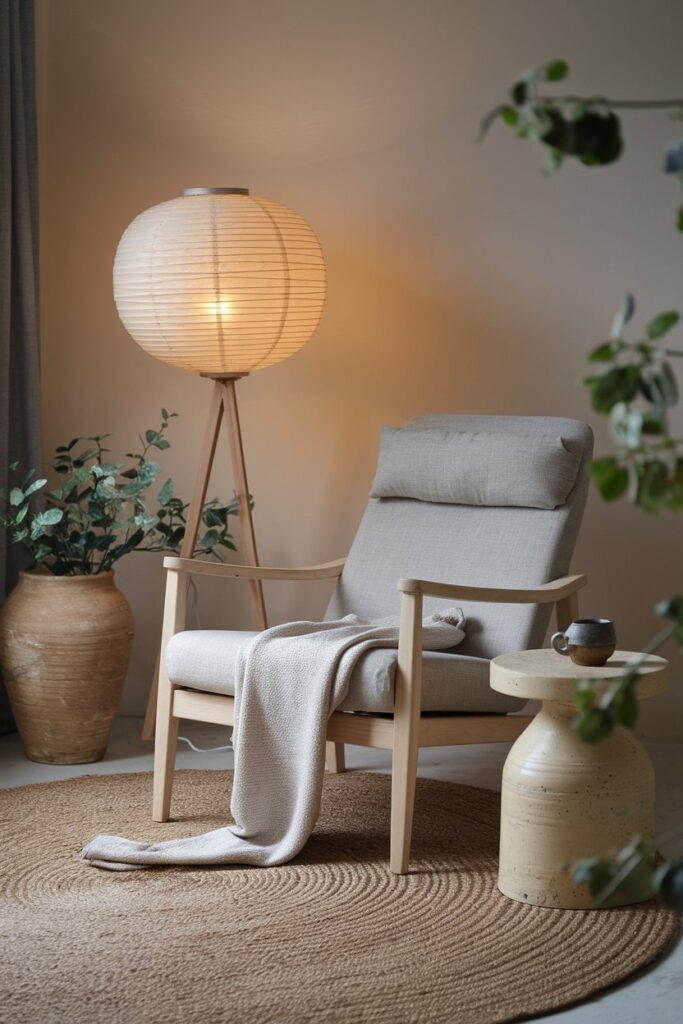
Start with a comfortable chair or low seating, paired with a soft rug and layered lighting. A nearby shelf or small table completes the setup.
Neutral tones and natural materials keep the look cohesive, while a throw blanket or cushion adds comfort.
This quiet space becomes a personal retreat-a place to pause, unwind, and enjoy the simple pleasures of slow living, perfectly aligned with Japandi philosophy.
26. Stone & Concrete Accents
Stone and concrete may seem raw, but in Japandi design, they bring a sense of grounded calm. These natural materials add depth and authenticity to the bedroom.
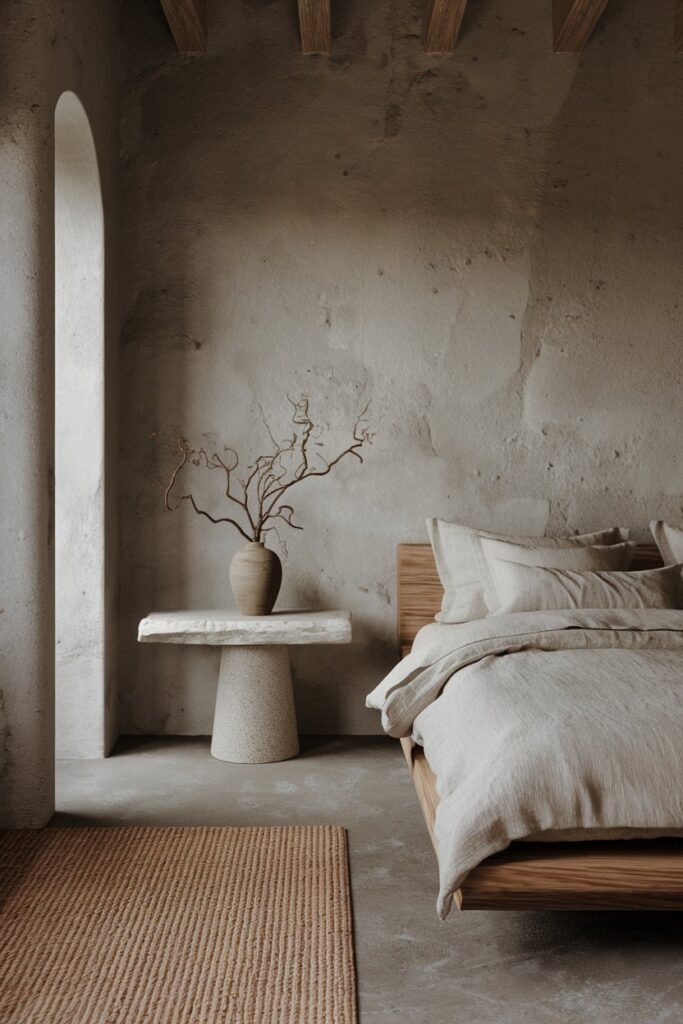
A bedside table in smooth concrete or a stone accent tray on a shelf creates subtle sophistication. Their textures contrast beautifully with soft linens and warm wood.
The key is balance-use stone or concrete sparingly so they don’t overwhelm the serene atmosphere. Think small decor pieces or a feature wall finish.
These accents remind us of the beauty of nature’s imperfections, reinforcing Japandi’s philosophy of simplicity and harmony.
27. Japandi Headboards
A headboard can anchor the entire bedroom, and in Japandi style, it should be understated yet full of character.
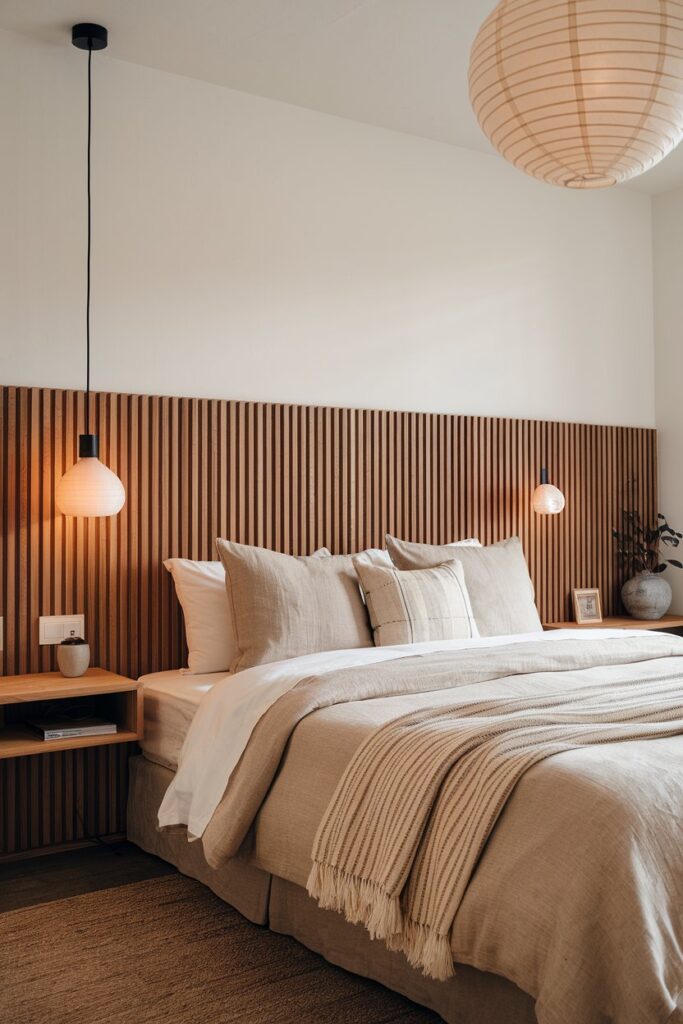
Wooden slat headboards bring rhythm and texture, while cane or upholstered linen options add softness. Each material complements Japandi’s focus on natural elements.
Low, wide headboards help create a sense of balance and proportion, echoing the Japanese approach to design.
By choosing a Japandi-inspired headboard, you elevate the bed as the room’s focal point while keeping the overall look simple and calming.
28. Subtle Black Accents
Black may be bold, but in a Japandi bedroom, it is used with subtlety and intention. It adds definition and contrast without breaking the serene flow.
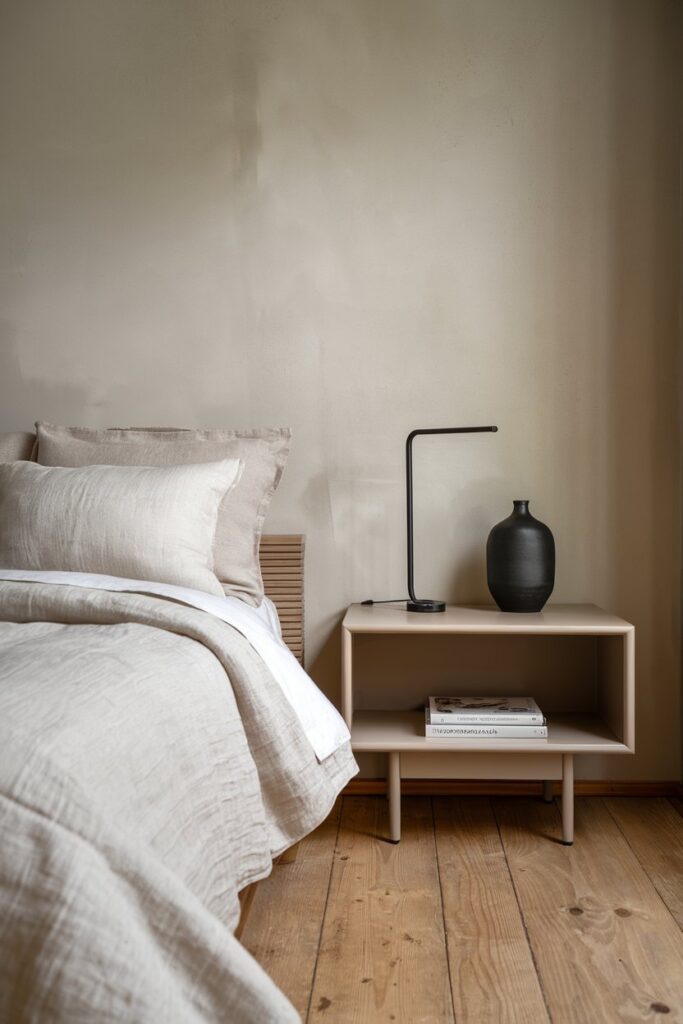
Think slim black lamp bases, drawer handles, or a delicate picture frame. These accents punctuate the space like brushstrokes in a minimalist painting.
When balanced with wood, stone, and soft fabrics, black creates a sense of depth and sophistication. It grounds the lighter tones of the palette.
Used sparingly, black accents give a Japandi bedroom just the right amount of modern edge.
29. Japandi Ceiling Beams
Exposed ceiling beams bring natural structure to a Japandi bedroom. They celebrate craftsmanship while adding warmth and character overhead.
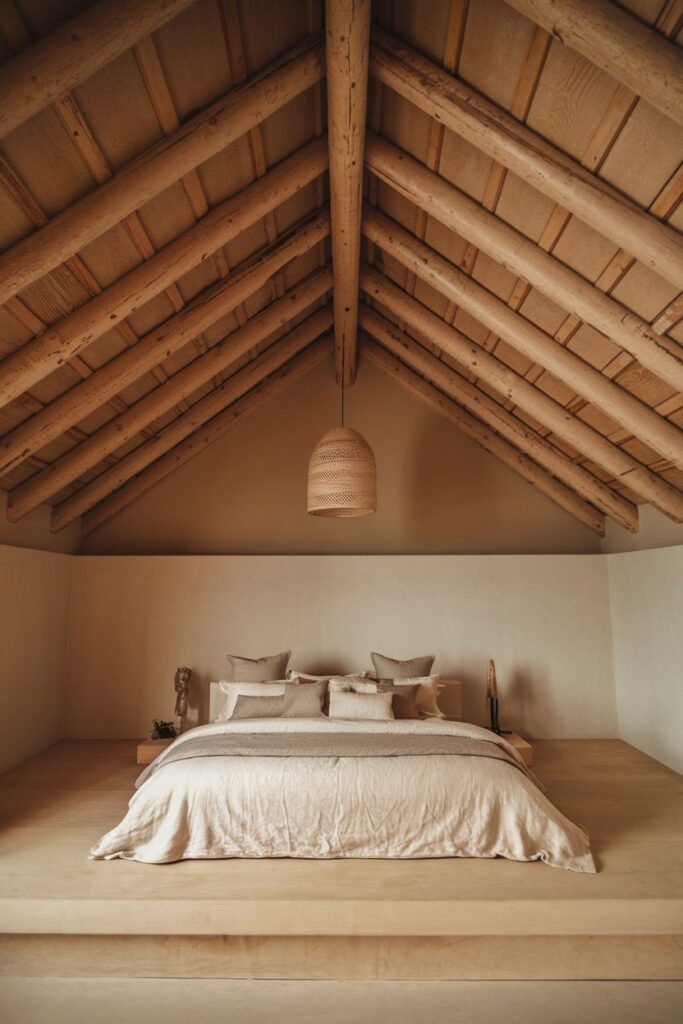
Light wood beams feel airy and Scandinavian, while darker tones draw from Japanese tradition. Either way, they create a striking architectural detail.
Paired with simple walls and minimal furnishings, beams become the star feature without overwhelming the space. They add depth and visual interest to the ceiling.
Incorporating beams reminds us of the beauty of natural architecture, tying together Japandi’s essence of form and function.
30. Serene Japandi Retreat
At its core, a Japandi bedroom is a retreat-a place to disconnect, recharge, and embrace simplicity. Every element works together to create this sense of serenity.
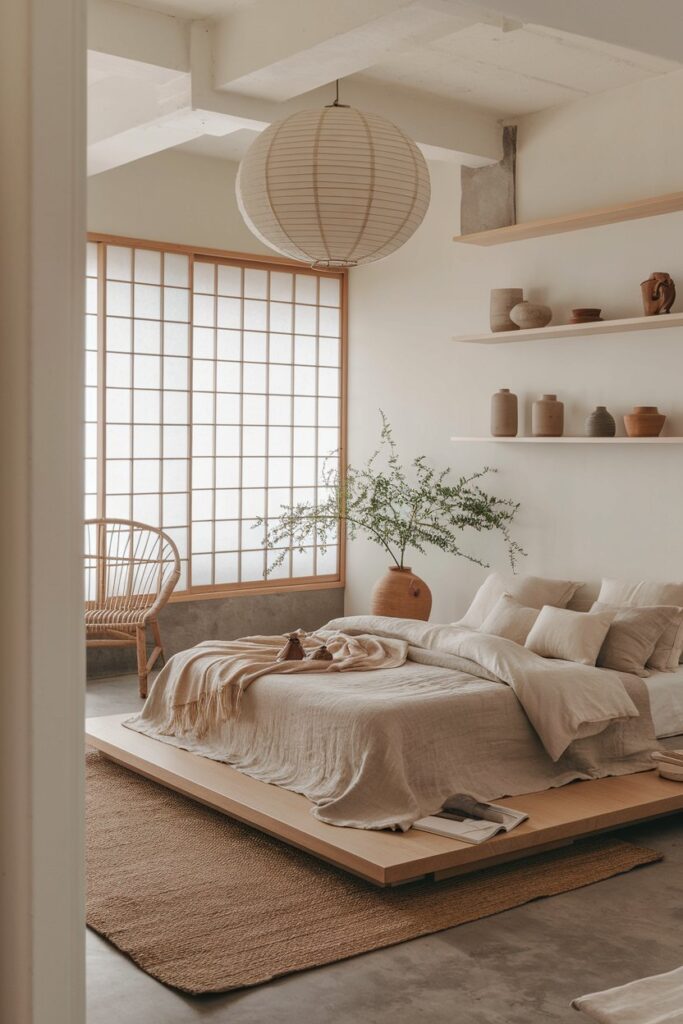
Neutral palettes, natural materials, and thoughtful furniture form the foundation. Layers of texture, subtle accents, and warm lighting bring comfort and balance.
The design avoids excess, focusing instead on quality, authenticity, and intention. Each piece feels chosen with care, contributing to harmony.
The result is more than just a bedroom-it’s a sanctuary that embodies Japandi’s timeless philosophy of mindful, inspired living.
Key Takeaways
- Japandi bedrooms embrace simplicity and function, blending Japanese minimalism with Scandinavian warmth.
- A neutral color palette sets the foundation, enhanced by natural textures like wood, stone, and linen.
- Low-profile furniture and clean-lined designs create balance while keeping the room grounded.
- Subtle wabi-sabi influences celebrate imperfections and bring authenticity to the space.
- Lighting and greenery play a crucial role in adding softness and calmness without clutter.
- Carefully chosen accents and materials-such as ceramic, concrete, or organic mirrors-add character without overwhelming.
The overall goal is a serene, functional retreat where beauty lies in balance, harmony, and calm.







